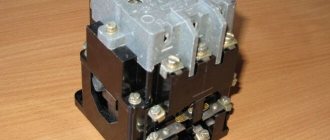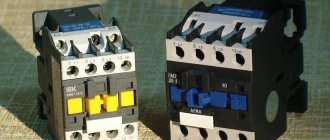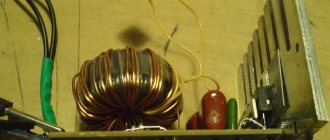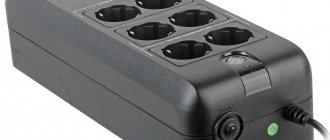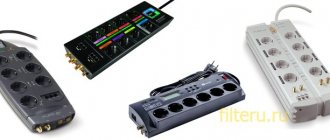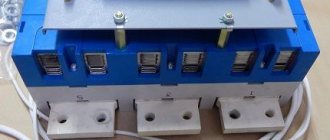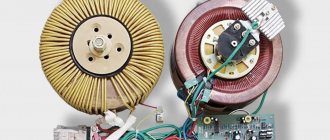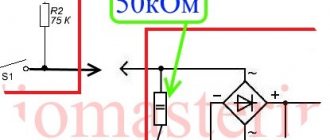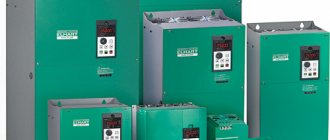Main switchboard (interpretation: main distribution board) is a low-voltage device that receives and distributes electrical energy to electrical consumers. Carries out accounting, protects group lines from overloads and short circuit currents.
Installations use:
- in office buildings;
- in apartment buildings;
- at industrial enterprises;
- in medical institutions;
- at other facilities with increased electrical safety requirements.
Used in alternating current networks with a solidly grounded neutral, with a voltage of no more than 380 V and a frequency of 50 Hz.
The devices are installed near powerful energy sources - transformer substations and generators (gas, diesel, gasoline). The first are intended to power the main panels, the second - backup.
Main distribution board (MSB)
The main ones are the switchboards on which power is distributed to several different objects. Typically, such switchboards are located in switchgears of electrical substations.
This is what the main switchboard looks like with open panels.
Typical equipment included in the main switchboard includes:
- power input;
- switches or disconnectors that provide a visible break in electrical circuits;
- automatic switches that protect electrical lines from damage due to short circuits;
- panel measuring instruments;
- in some cases, electricity meters.
When the main switchboard is located in the room of a step-down transformer substation
, power input is carried out by cable line or busbar. If the main switchboard is located at intermediate points connected to the supply substation by a 0.4 kV overhead line, the input can be organized directly from it through bushings.
Both at the power input and at each of the outgoing lines, two switching devices are installed in series - a circuit breaker and a switch (disconnector). The switch is used to disconnect the power line under load. StabExpert.ru reminds that the breaking capacity of the circuit breaker is calculated in such a way that it can break the short circuit current of the protected line. An input switch is installed at the power input, which is superior in rating to outgoing line circuit breakers, since the total current of all powered objects flows through the input.
The main area of protection for the input switch is the internal wiring of the main distribution board. In addition, its functions include redundancy of protection for outgoing lines.
The mutual characteristics of the input and linear automata are selected in such a way that if the outgoing line is damaged, the linear automaton is triggered first. If it fails, the power input is turned off to avoid damage to the equipment. This is achieved either by an artificial time delay in turning off the input, or by appropriate selection of the characteristics of the integral protection elements of the circuit breakers.
The following can be used as circuit breakers:
- conventional manually operated automatic machines equipped with electromagnetic and thermal releases;
- switches controlled remotely from control rooms, equipped with remote or built-in relay protection devices.
In the second option, information about the current state of the switches and the facts of protection activation is transmitted to the control center via special alarm and control lines.
Switches and disconnectors are usually not designed to disconnect load currents, much less emergency currents. They are intended to provide a visible break when performing repair work, which is required by safety regulations. Also, the switchboard switches of the main distribution board are used when shutting down the load line or the entire switchboard (using an input switch).
Traditional pointer voltmeters and ammeters, as well as more modern digital ones, can be used as panel devices. Combined panel measuring units have a digital scale, which, depending on the selected display mode, can show the value of one of the following parameters:
- voltage;
- current;
- instantaneous value of active or reactive power;
- consumption of active or reactive energy.
Marking of electrical panels
The wires of all internal circuits must be color coded. It must have a sharp contrast and be resistant to abrasion. Terminals for PE and N conductors that extend from distribution and group circuits should be marked with serial numbers. If connecting wires to the device terminals is difficult, then intermediate clamps must be provided. The clamps must also be marked with serial numbers.
A sign with information must be placed on the door on the outside of the main switchboard. Typically the nameplate contains the following information:
- Manufacturer's name.
- Type designation.
- Device protection level.
- Rated current of the ASU.
- Weight.
- Identification of all technical conditions.
- Date of manufacture.
- Additional Information.
Marking in the main switchboard
Input switchgear (IDU)
The input switchgear is a type of distribution board installed at the power input of an object (building, private house, production workshop, etc.). The general purpose of the ASU switchboard is similar to the functions of the main distribution board. StabExpert.ru reminds that the difference lies in the fact that the main switchboard distributes power between objects that may be located at a distance from each other, and the input switchgear feeds the electrical wiring lines within one object (building).
An example of an ASU shield.
The completeness and design of the ASU may vary. The most common type is in the form of a metal cabinet. Typical models of incoming cabinets for power supply of multi-storey residential buildings and various production facilities have a three-phase design.
For ease of power distribution, a three-phase busbar system is mounted inside the cabinet, to which the outgoing cable cores are attached. Thanks to the use of busbars as internal conductors, the entire installation acquires the necessary mechanical stability.
Quite often there are ASU models that do not have circuit breakers. Switches play the role of switching devices. The switch control drive can be routed outside the cabinet. The control knob is located on the right side wall. In such cases, the front door of the cabinet is equipped with a special lock that prevents it from opening when the input position is on. This ensures the required level of safety during maintenance.
In the absence of a circuit breaker, the current protection functions are performed by fuses.
In some cases, the input distribution device is combined with a metering cabinet. In this option, an electricity meter is installed in a separate compartment of the ASU. Since the described cabinets are usually designed to power fairly powerful consumers, the meter's current circuits are connected through special measuring current transformers. The primary windings of such transformers, usually made in the form of short busbars, are connected in a gap (that is, in series) to each of the three phases of the power input. The secondary windings of the current transformers are connected to the meter terminals with insulated copper wire.
What are the similarities and differences between the main switchboard and the ASU?
The main distribution board (MSB) and the input distribution device (IDU) perform almost the same functions:
- reception and distribution of electrical energy received from external sources;
- protection of power lines from overloads and short circuits;
- electricity metering and automatic switching on of backup power (these options may not be available on some products).
The functional similarity of these switchgears is emphasized by the definition of clause 7.1.4. PUE, which states that the ASU can serve as the main distribution board.
However, there is a fundamental difference between these distribution devices. The input-distribution device is always located at the facility's power input, while the main switchboard, in addition, can be located on the territory of the supply substation, performing the functions of a low-voltage switchgear.
Main switchboards and ASUs, as a rule, also differ in design. The main switchboard is a set of several voluminous cabinets - panels; the equipment of the input distribution device (IDU) is usually located in one cabinet of a relatively small volume. ASUs consisting of several cabinets are much less common.
The difference in technical characteristics is significant, since the maximum operating current of the input switching devices ASU, given in GOST R 51732-2001, is 630 amperes. Certain models of main distribution boards, mass-produced by Russian manufacturers, are designed for an operating current of 4000 amperes or more. This circumstance allows us to classify the main switchboard as a group of switchgears located at a higher level of the hierarchy than the ASU.
Backup power connection panel (ABP)
The need to install shields of this type arises in cases where the facility has several power sources, where at least one of them is in reserve. In this case, if there is no voltage in the working power line, a switch must be made to the spare one.
There are various design and configuration options for transfer switch cabinets. Most of them are designed to work with two lines, but there are more. Cabinet designs imply manual or automatic (AVR) switching on of backup power.
AVR panel with emergency signal.
In the first version, the cabinet has two power inputs, each of which has its own switching equipment and instrumentation. In normal mode, the switch or switch of the working power input is turned on, the backup input is turned off. If the voltage at the working input disappears, it is necessary to manually switch.
If back-to-back switching on of power supplies is unacceptable, switching devices can be interlocked in such a way that their simultaneous switching on is impossible.
The connection of outgoing lines is carried out similarly to conventional distribution cabinets.
ATS cabinets are equipped with special automation that monitors the voltage at the power inputs and, if necessary, automatically switches them. StabExpert.ru reminds that switching in this case is carried out by magnetic starters, and blocking from simultaneous switching on of inputs is provided by the electrical circuit of the automation.
The supply line can have the status of working or standby, or both lines are considered working. In the first case, power supply according to the normal circuit occurs only from a working source, the backup line is turned on only for periods of emergency situations. When working power is restored, the object is reconnected to it. If the power lines are equal, any of them can be turned on in operating mode.
The priority of power from a specific source is often relevant when organizing power supply to industrial facilities. This issue can have both an economic and a technical aspect.
Power supply may be provided by different electricity suppliers, the price of which may vary. In this case, it is natural to choose a cheaper source as the main one. The same thing happens with a standby autonomous generator, the cost of electricity is higher than the network one. As a rule, such situations do not arise for a household consumer. In some cases, one of the power lines may have a power limitation. Such a source cannot always be used as a working one.
Another version of the power supply circuit from two sources is typical for industrial switchgear. Its essence lies in the fact that all consumers of the facility are divided into two groups, each of which is connected to its own 0.4 kV section. In operating mode, the sections are isolated from one another and are each powered from its own source. When the voltage disappears on one of them, the section switch or starter is turned on. That is, in an emergency, the sections are combined and continue to be powered from the line remaining in operation.
A special case of the ATS cabinet design is an option when backup power is provided by an autonomous generator.
Such a cabinet contains specific automation, which not only monitors the presence of voltage and performs switching, but also starts the backup generator.
To implement non-standard circuits containing several different power options, cabinets of the required configuration are made to special order.
Floor electrical panel (ESB)
Switchboards of this type belong to a lower hierarchy of distribution boards. The purpose of this device is determined by its name. Through the electrical switchboard, electricity is distributed to consumers located on a specific floor. And in the case of an administrative building, outgoing electrical wiring lines can provide power to individual offices or groups of them.
Everyone knows ESH.
In a residential apartment building, a floor electrical panel distributes electricity to apartments on one landing. In this case, it may contain meters for metering the electricity consumed by each apartment. If there are electricity meters in the switchboard, they can be located in a separate compartment, which, if necessary, can be sealed by representatives of regulatory authorities.
Panels of this type, unlike the previously considered types, necessarily contain automatic switches. Modern versions of electrical panels are produced in a modular version; the machines are installed in them on a DIN rail.
Grsch - what is it?
The main switchboard (main distribution board) is understood as a device that distributes electricity within one building, structure or enterprise. Often it contains devices that allow you to keep track of energy consumption - meters.
Some manufacturers sometimes include automatic emergency devices in the main switchboard, which notify all employees of the enterprise about problems in the system.
It should be noted that main distribution boards have found their application not only on the territory of industrial complexes, but also in public buildings, for example, in kindergartens and schools.
A few words need to be said about the industrial production of main switchboards. Their installation is carried out between a special substation and an input device or directly in contact with the main consumer.
The design, development of a configuration plan and assembly of this device are directly related to the need to rationally distribute all incoming electricity, transmit it to each consumer in the required quantities, as well as reduce the risk of short circuits and all kinds of equipment overloads. Accounting for energy consumption, as mentioned above, is carried out using special meters. With their help, you can control your energy costs visually, at any time that suits you. Some enterprises engaged in the manufacture of main switchboards, as well as a distribution point included in the range of services they provide, can give the system they create remote control and recording of all results, which will be carried out automatically. After the main distribution board has been installed at the place where it is directly installed, it is necessary to connect it to power cables or special input busbars.
Requirements for the quality of manufacturing of the main switchboard and its configuration
It should be noted that the quality of assembly of the main distribution board is primarily influenced by the quality of the materials that will be used to manufacture the housing, as well as the correct installation of the equipment used.
note
In order for the products to fully comply with modern quality standards, it is necessary to establish the use of start-up and power distribution equipment of the highest quality.
In order to significantly increase the service life of the main switchboard, specialists began to introduce pieces of copper into the tires that are part of them.
Features of the main distribution board
First of all, the main switchboard must perform a protective and distribution function. The protective function appears during short circuits, because it is with its help that the entire emergency line is turned off, on which selective protection of all electrical equipment will be installed.
It also implies, in particularly critical situations, the activation of an emergency power system, which will help some devices survive until the equipment is repaired.
Also, by introducing logical control circuits into the main switchboard system, it was possible to make an almost instantaneous transition in automatic mode from the main input to the backup one, which allows for a smooth transition from emergency mode to operating mode.
This automation of the control of the main distribution board can significantly reduce the cost of its maintenance, and the number of company employees who need to work on it is significantly reduced.
Non-standard production of main switchboards
The management of some enterprises often wants to introduce a main distribution board into their production area, which will be manufactured in accordance with their wishes.
In such cases, the manufacture of the main switchboard occurs in a short time, regardless of the complexity of the work performed.
Important
In this case, the client is usually guaranteed complete confidentiality and uniqueness of the product, which will meet all requirements in the field of electrical engineering and be fully equipped. Delivery will be carried out in record time.
Source: “QUANTUM ELEKTRO”.
Source: https://www.pnzstroi.ru/repair/article/42002/grsch-chto-eto-takoe
Indoor distribution board
It is located inside the apartment and serves to distribute electricity among rooms or groups of consumers, depending on the existing project. In some cases, the apartment switchboard may also contain an electricity meter. If there is a residual current device (RCD), it is also located in this panel.
Apartment panel with accounting device.
Lighting board (SHB)
In ShchO the lighting load is distributed, this is relevant in office and administrative buildings. At such facilities, the electrical load is divided into the power part (socket groups, separate ventilation and air conditioning devices, etc.) and the lighting itself.
Example of a ShchO with a lock.
In conclusion, it is worth adding that the installation of electrical distribution panels at any power supply facility is carried out strictly in accordance with the electrical part of the construction project. The design documentation provides for the required number of control panels, their internal layout and installation locations.
What is the difference between VU, ASU, and main switchboard: the answer is in the standards
Introduction
Before finding out how the VU, ASU, and main switchboards differ, let us remember what the abbreviations given in the title of the article mean.
- VU is an abbreviation for input device;
- VRU is an abbreviation for input distribution devices;
- Main switchboard is the designation of the main distribution board.
All these devices share a supply circuit coming from substations or branches of overhead lines from the distribution networks of buildings, structures, houses and other electrical installations.
When planning the installation of an input device, you need to take into account the total power of all available electricity consumers in the house.
note
Particular attention is paid to houses heated by electric boilers. The boiler's power can account for the lion's share of the energy consumption of the entire house.
Calculation of boiler power is carried out by calculating the required heating radiators, their heat transfer and energy efficiency. Efficient bimetallic and aluminum heating radiators will help reduce the boiler power. Their prices are low, as you can see for yourself by looking at aluminum radiators in Ufa.
VU, ASU and main switchboard
It is important to note that VU, ASU and main switchboards belong to the same group of devices that have the same purpose in electrical circuits; they separate the supply electrical circuit from substations, transformers, VLI branches from the electrical circuit of a house, building, workshop, etc.
The input device on the site is installed on a support.
Hence, the second purpose of these devices is that they divide the areas of responsibility between the service organizations of the power supply networks of the city, town, district and the consumer.
- Applicable to a private house, everything that is located behind the VU, ASU and main switchboard is serviced by the owner.
- Applicable to an apartment, the areas of distribution of responsibility are somewhat shifted towards the end consumer (tenant). The VU, ASU and main switchboard at home are located in the electrical switchboard room, and the resident’s area of responsibility begins after the floor switchboard, or apartment switchboard if it is installed in the apartment.


